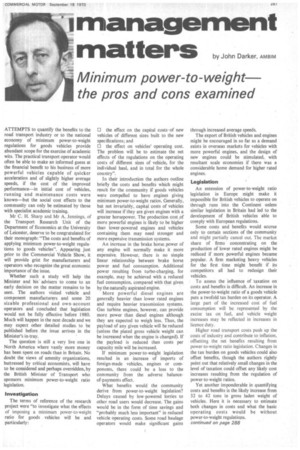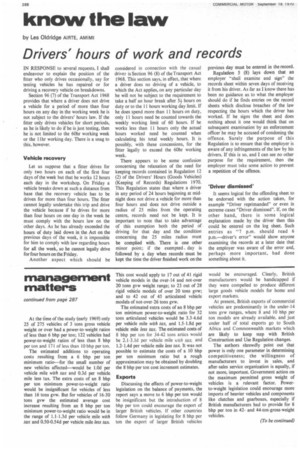Imanagement •
Page 289

Page 290

If you've noticed an error in this article please click here to report it so we can fix it.
matters by John Darker, AMBIM
Minimum power-to-weight the pros and cons examined
ATTEMPTS to quantify the benefits to the road transport industry or to the national economy of minimum power-to-weight regulations for goods vehicles provide abundant scope for the exercise of academic wits. The practical transport operator would often be able to make an informed guess at the financial benefit to his business of more powerful vehicles capable of quicker acceleration and of slightly higher average speeds, if the cost of the improved performance—in initial cost of vehicles, running and maintenance costs were known—but the social cost effects to the community can only be estimated by those with specialist academic training.
Mr C. H. Sharp and Mr A. Jennings, of the Transport Research Unit of the Department of Economics at the University of Leicester, deserve to be congratulated for their monograph: "The costs and benefits of applying minimum power-to-weight regulations to goods vehicles". Appearing just prior to the Commercial Vehicle Show, it will provide grist for manufacturers and operators who recognize the great economic importance of the issue.
Whether such a study will help the Minister and his advisers to come to an early decision on the matter remains to be seen. The authors visited vehicle and component manufacturers and some 20 sizable professional and own-account operators and concluded that legislation would not be fully effective before 1980. Much will happen in the next decade and we may expect other detailed studies to be published before the issue arrives in the Minister's in-tray.
The question is still a very live one in North America where vastly more money has been spent on roads than in Britain. No doubt the views of amenity organizations, buttressed by critical economists, will have to be considered and perhaps overridden, by the British Minister of Transport who sponsors minimum power-to-weight ratio legislation.
Investigation
The terms of reference of the research project were "to investigate what the effects of imposing a minimum power-to-weight ratio for goods vehicles will be and particularly: CI the effect on the capital costs of new vehicles of different sizes built to the new specifications; and 171 the effect on vehicles' operating cost. The problem will be to estimate the net effects of the regulations on the operating costs of different sizes of vehicle, for the individual haul, and in total for the whole country".
In their introduction the authors outline briefly the costs and benefits which might result for the community if goods vehicles were compelled to have engines giving minimum power-to-weight ratios. Generally, but not invariably, capital costs of vehicles will increase if they are given engines with a greater horsepower. The production cost ,of more powerful engines is likely to be higher than lower-powered engines and vehicles containing them may need stronger and more expensive transmission systems.
An increase in the brake horsepower of any engine will normally make it more expensive. However, there is no simple linear relationship between brake horse power and fuel consumption. Additional power resulting from turbo-charging, for example, may be achieved with a reduced fuel consumption, compared with that given by the naturally aspirated engine.
More powerful diesel engines are generally heavier than lower rated engines and require heavier transmission systems. Gas turbine engines, however, can provide more power than diesel engines although they are expected to weigh less. Thus, the payload of any given vehicle will be reduced (unless the plated gross vehicle weight can be increased when the engine is changed). If the payload is reduced then costs per capacity mile will be increased.
If minimum power-to-weight legislation resulted in an increase of imports of foreign-made vehicles, engines or components, there could be a loss to the community from the adverse balanceof-payments effect.
What benefits would the community derive from power-to-weight legislation? Delays caused by low-powered lorries to other road users would decrease. The gains would be in the form of time savings and "probably much less important" in reduced vehicle operating costs. Some road haulage operators would make significant gains through increased average speeds.
The export of British vehicles and engines might be encouraged in so far as a demand exists in overseas markets for vehicles with more powerful engines, and the design of new engines could be stimulated, with resultant scale economies if there was a considerable home demand for higher rated engines.
Legislation
An extension of power-to-weight ratio legislation in Europe might make it impossible for British vehicles to operate on through runs into the Continent unless similar legislation in Britain had led to the development of British vehicles able to comply with European regulations.
Some costs and benefits would accrue only to certain sections of the community and might partially cancel out. The market share of firms concentrating on the production of lower rated engines might be redoced if more powerful engines became popular. A firm marketing heavy vehicles for the first time might benefit if its competitors all had to redesign their vehicles.
To assess the influence of taxation on costs and benefits is difficult. An increase in the power-to-weight ratio of a goods vehicle puts a twofold tax burden on its operator. A large part of the increased cost of fuel consumption will be represented by the excise tax on fuel, and vehicle weight increases may be reflected in increases in licence duty.
Higher road transport costs push up the costs of industry and contribute to inflation, offsetting the net benefits resulting from power-to-weight ratio legislation. Changes in the tax burden on goods vehicles could also offset benefits, though the authors rightly point out that relatively small changes in the level of taxation could offset any likely cost increases resulting from the regulation of power-to-weight ratios.
Yet another imponderable in quantifying costs and benefits is the likely increase from 32 to 42 tons in gross laden weight of vehicles. Here it is necessary to estimate both changes in costs and what the basic operating costs would be without power-to-weight regulations. At the time of the study (early 1969) only 25 of 275 vehicles of 3 tons gross vehicle weight or over had a power-to-weight ratios of less than 6 bhp per ton; 122 vehicles had power-to-weight ratios of less than 8 bhp per Lon and 171 of less than 10 bhp per ton.
The estimated additions to operating costs resulting from a 6 bhp per ton minimum ratio—for the small number of new vehicles affected—would be I.Od per vehicle mile with tax and 0.3d per vehicle. mile less tax. The extra costs of an 8 bhp per ton minimum power-to-weight ratio would be insignificant for vehicles of less than 16 tons gvw. But for vehicles of 16-30 tons gvw the estimated average cost increase resulting from an 8 bhp per ton minimum power-to-weight ratio would be in the range of 1.1-1.3d per vehicle mile with tax and 0.50-0.54d per vehicle mile less tax.
This cost would apply to 17 out of 41 rigid vehicle models in the over-14 and not-over 20 tons gvw weight range; to 23 out of 28 rigid vehicle models of over 20 tons gvw; and to 42 out of 45 articulated vehicle models of not-over-26 tons gvw.
The estimated extra costs of an 8 bhp per ton minimum power-to-weight ratio for 32 tons articulated vehicles would be 3.3-4.6d per vehicle mile with tax, and 1.5-1.8d per vehicle mile less tax. The estimated costs of 8 bhp per ton for 34-42 tons artics would be 2.1-3.1d per vehicle mile with tax, and 1.2-1.4d per vehicle mile less tax. It was not possible to estimate the costs of a 10 bhp per ton minimum ratio but a rough approximation may be obtained by doubling the 8 bhp per ton cost increment estimates.
Exports
Discussing the effects of power-to-weight legislation on the balance of payments, the report says a move to 6 bhp per ton would be insignificant but the introduction of 8 bhp per ton could encourage the export of larger British vehicles. If other countries follow Germany in legislating for 8 bhp per ton the export of larger British vehicles would be encouraged. Clearly. British manufacturers would be handicapped if they were compelled to produce different large goods vehicle models for home and export markets.
At present, British exports of commercial vehicles are predominantly in the under-14 tons gvw ranges, where 8 and 10 bhp per ton models are already available, and just under half of total exports go to South Africa and Commonwealth markets which are likely to keep step with British Construction and Use Regulation changes.
The authors shrewdly point out that power is only one parameter in determining competitiveness; the willingness of manufacturers to invest in sales, and after-sales service organization is equally, if not more, important. Government action on the maximum permitted gross weight of vehicles is a relevant factor. Powerto-weight legislation could encourage more imports of heavier vehicles and components like clutches and gearboxes, especially if British manufacturers had to provide for 8 bhp per ton in 42and 44-ton-gross-weight vehicles.






























































































































































































































































































































































































